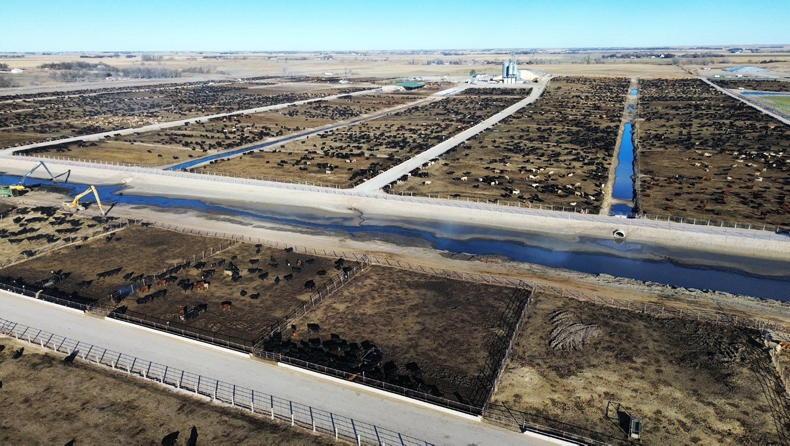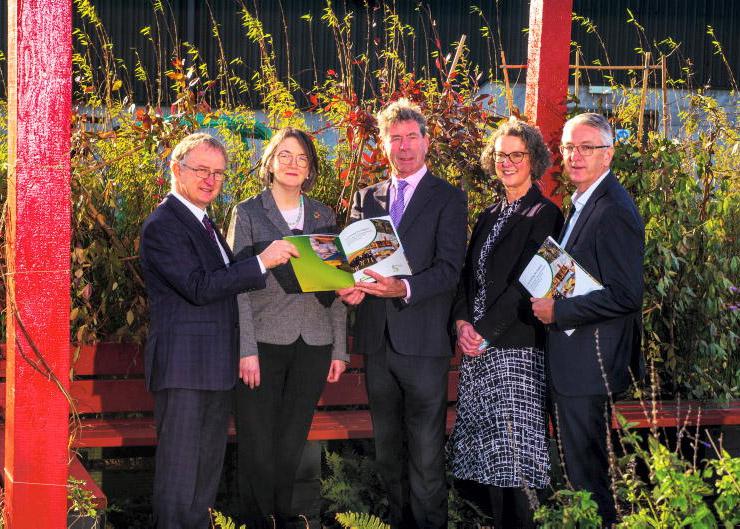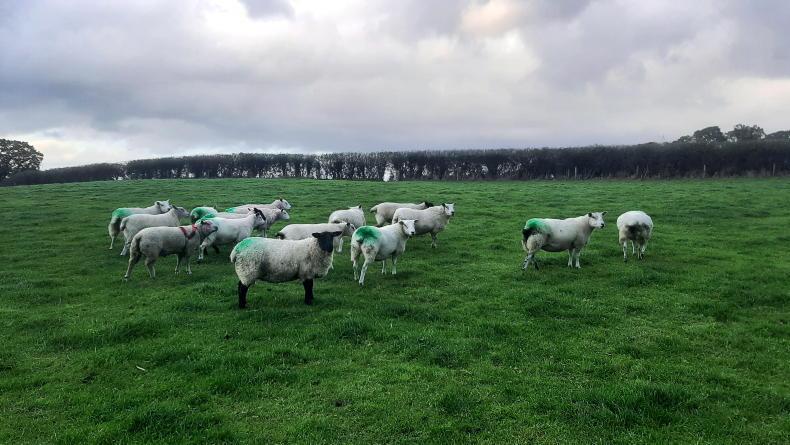Teagasc has forecast a 3% increase in average farm incomes following the EU-UK trade deal agreed on Christmas Eve.
Its revised outlook for farm incomes in 2021 is a dramatic change from the 18% drop in incomes which it forecast in November, made on the basis of a no-deal Brexit.
The prediction of a 3% increase would bring the average Irish farm income to around €25,600 and is based on there being no further market disruption caused by COVID-19.
With the exception of pigs, where prices are predicted to fall by 10% due to reduced demand in global markets outside Europe, the other main sectors of Irish agriculture are expected to have price increases.
Modest increases in milk prices are forecast which, along with increased milk production, should offset most of the higher production costs and leave dairy net margin at €1,296/ha, 1% lower than 2020.
Rising lamb prices are expected to give an increase of net margin per hectare of 9% in 2021
Beef and sheepmeat prices are predicted to increase by 4% and, despite also having increased production costs, cattle finishers and suckler farm margins per hectare are forecast to increase by 5% – though this means they are still loss-making, as explained by Adam Woods below.
Rising lamb prices are expected to give an increase of net margin per hectare of 9% in 2021, while on tillage farms a combination of higher production, better income from secondary livestock enterprises and a pilot straw-chopping scheme are forecast to increase incomes by 17% in 2021.
Beef: Suckler
sector will
continue to
struggle despite
forecast income rise
– Adam Woods
While the headlines of an increase of between 3-6% in beef farmer income forecast for 2021 by Teagasc may seem positive, you need to dig a little deeper to get the real detail on the 2021 outlook for the beef sector.
The reality is that single suckling farms are forecast to deliver a net margin of -€28/ha in 2021, while cattle finishing enterprises will deliver a net margin of -€42/ha.
The forecast R3 steer beef price of €3.98/kg for 2021 by the Teagasc economic unit is still a long way off the €4.50/kg that the Teagasc specialist unit says winter finishers require to break even in 2021.
The importance of farm schemes in the beef figures was never more evident. BDGP is contributing €41/ha to the bottom line, while BEEP-S is contributing €44/ha. Without these supports, suckler systems would be in big trouble.
The authors also state that in the absence of the Beef Finisher Payment scheme (BFP), the average gross margin on cattle finishing farms would have decreased by 15% in 2020.
Interestingly they go on to note: “We assume that the value of the BFP continues to support cattle enterprises in 2021 and therefore continues to mitigate against the adverse impact of COVID-19 on farm incomes,” which would lead farmers to expect the scheme to continue for 2021.
Dairy: Forecast is cautious in view of recent market trends
– Jack Kennedy
The Teagasc predictions on input price increases would largely be in line with expectations as milk suppliers are currently purchasing feed and fertiliser at increased prices relative to 2020.
How 2021 actually pans out in terms of inputs required depends to a large extent on weather, as very wet or indeed very dry weather later in summer could affect inputs considerably.
The Teagasc outlook on milk prices looks to be on the pessimistic side, given the recent market movements and the exceptional prices being paid in New Zealand as the season is coming to an end. Recent GDT auctions results showing consecutive increases for the last seven auctions, European prices on an upward trend and the lift in January milk prices aligned to stability in world markets would suggest 2021 should be a better year on milk price than 2020.
The Teagasc forecast is only for a very marginal increase in milk price compared to 2020. The Teagasc forecast analysis should describe milk price in euro per kilo milk solids rather than cent per litre.
Tillage - Price
estimate for 2021 is
the main surprise
– Andy Doyle
The review of the tillage sector for 2020 sums up the vagaries of the year that was. Low winter cereal plantings, significant over-winter crop damage, a spring drought, rejection for malting and serious challenges during harvest, seriously hit the output of grain and straw. So, it is no surprise that gross margins were lower across all the main cereals.
What is a surprise is Teagasc’s prediction of a 5% reduction in harvest cereal price levels compared to last harvest. While this is a calculated assessment based on futures, forward prices available to growers today for harvest are, at worst, similar to last year but generally better.
Sheep – Irish lamb will be in demand this year
– Phelim O’Neill
Teagasc is optimistic that sheepmeat prices in 2021 will continue to increase on the already strong prices of 2020 and these will more than offset the increased on farm production costs. Given the post-Brexit non-tariff barriers on the UK and New Zealand’s growing focus on China, Ireland will be in a strong position to supply the EU market in 2021. There is the issue of an EU-Australia and a UK–Australia trade creating a much larger supply of sheepmeat to both the EU and UK in the medium term. This would create competition for Irish sheep producers in the EU market from both Australian and British sheepmeat but that will not affect the current year. It is one to watch though.
Teagasc has forecast a 3% increase in average farm incomes following the EU-UK trade deal agreed on Christmas Eve.
Its revised outlook for farm incomes in 2021 is a dramatic change from the 18% drop in incomes which it forecast in November, made on the basis of a no-deal Brexit.
The prediction of a 3% increase would bring the average Irish farm income to around €25,600 and is based on there being no further market disruption caused by COVID-19.
With the exception of pigs, where prices are predicted to fall by 10% due to reduced demand in global markets outside Europe, the other main sectors of Irish agriculture are expected to have price increases.
Modest increases in milk prices are forecast which, along with increased milk production, should offset most of the higher production costs and leave dairy net margin at €1,296/ha, 1% lower than 2020.
Rising lamb prices are expected to give an increase of net margin per hectare of 9% in 2021
Beef and sheepmeat prices are predicted to increase by 4% and, despite also having increased production costs, cattle finishers and suckler farm margins per hectare are forecast to increase by 5% – though this means they are still loss-making, as explained by Adam Woods below.
Rising lamb prices are expected to give an increase of net margin per hectare of 9% in 2021, while on tillage farms a combination of higher production, better income from secondary livestock enterprises and a pilot straw-chopping scheme are forecast to increase incomes by 17% in 2021.
Beef: Suckler
sector will
continue to
struggle despite
forecast income rise
– Adam Woods
While the headlines of an increase of between 3-6% in beef farmer income forecast for 2021 by Teagasc may seem positive, you need to dig a little deeper to get the real detail on the 2021 outlook for the beef sector.
The reality is that single suckling farms are forecast to deliver a net margin of -€28/ha in 2021, while cattle finishing enterprises will deliver a net margin of -€42/ha.
The forecast R3 steer beef price of €3.98/kg for 2021 by the Teagasc economic unit is still a long way off the €4.50/kg that the Teagasc specialist unit says winter finishers require to break even in 2021.
The importance of farm schemes in the beef figures was never more evident. BDGP is contributing €41/ha to the bottom line, while BEEP-S is contributing €44/ha. Without these supports, suckler systems would be in big trouble.
The authors also state that in the absence of the Beef Finisher Payment scheme (BFP), the average gross margin on cattle finishing farms would have decreased by 15% in 2020.
Interestingly they go on to note: “We assume that the value of the BFP continues to support cattle enterprises in 2021 and therefore continues to mitigate against the adverse impact of COVID-19 on farm incomes,” which would lead farmers to expect the scheme to continue for 2021.
Dairy: Forecast is cautious in view of recent market trends
– Jack Kennedy
The Teagasc predictions on input price increases would largely be in line with expectations as milk suppliers are currently purchasing feed and fertiliser at increased prices relative to 2020.
How 2021 actually pans out in terms of inputs required depends to a large extent on weather, as very wet or indeed very dry weather later in summer could affect inputs considerably.
The Teagasc outlook on milk prices looks to be on the pessimistic side, given the recent market movements and the exceptional prices being paid in New Zealand as the season is coming to an end. Recent GDT auctions results showing consecutive increases for the last seven auctions, European prices on an upward trend and the lift in January milk prices aligned to stability in world markets would suggest 2021 should be a better year on milk price than 2020.
The Teagasc forecast is only for a very marginal increase in milk price compared to 2020. The Teagasc forecast analysis should describe milk price in euro per kilo milk solids rather than cent per litre.
Tillage - Price
estimate for 2021 is
the main surprise
– Andy Doyle
The review of the tillage sector for 2020 sums up the vagaries of the year that was. Low winter cereal plantings, significant over-winter crop damage, a spring drought, rejection for malting and serious challenges during harvest, seriously hit the output of grain and straw. So, it is no surprise that gross margins were lower across all the main cereals.
What is a surprise is Teagasc’s prediction of a 5% reduction in harvest cereal price levels compared to last harvest. While this is a calculated assessment based on futures, forward prices available to growers today for harvest are, at worst, similar to last year but generally better.
Sheep – Irish lamb will be in demand this year
– Phelim O’Neill
Teagasc is optimistic that sheepmeat prices in 2021 will continue to increase on the already strong prices of 2020 and these will more than offset the increased on farm production costs. Given the post-Brexit non-tariff barriers on the UK and New Zealand’s growing focus on China, Ireland will be in a strong position to supply the EU market in 2021. There is the issue of an EU-Australia and a UK–Australia trade creating a much larger supply of sheepmeat to both the EU and UK in the medium term. This would create competition for Irish sheep producers in the EU market from both Australian and British sheepmeat but that will not affect the current year. It is one to watch though.










SHARING OPTIONS